
Hypogymnia is a genus of foliose lichens in the family Parmeliaceae. They are commonly known as tube lichens, bone lichens, or pillow lichens. Most species lack rhizines that are otherwise common in members of the Parmeliaceae, and have swollen lobes that are usually hollow. The lichens usually grow on the bark and wood of coniferous trees.
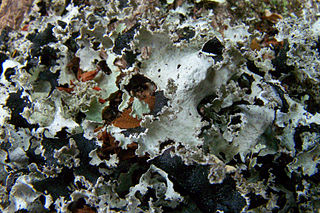
Platismatia is genus of medium to large foliose lichens with rather crinkled lobes. The genus is widespread and contains 10 species. They resemble many other genera of foliose lichens in the family Parmeliaceae, particularly Parmotrema, Cetrelia, and Asahinea. Most species are found in forests on the trunks and branches of conifer trees, although some species grow on rocks.

Esslingeriana is a fungal genus in the family Parmeliaceae. The genus is monotypic, containing the single foliose lichen species Esslingeriana idahoensis, commonly known as the tinted rag lichen. It is found in northwestern North America.
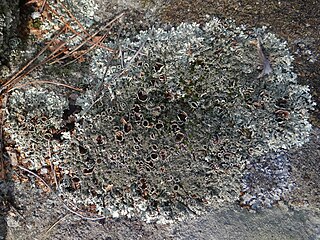
Xanthoparmelia conspersa, commonly known as the peppered rock-shield, is a foliose lichen and the type species of genus Xanthoparmelia. It is widely distributed in temperate zones, and has been recorded from Japan, Europe, Africa, North America, and South America.
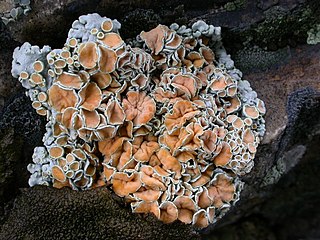
Rhizoplaca chrysoleuca is a pale yellowish-green to gray-green umbillicate foiliose lichen in the Lecanoraceae family. It was first described in 1791 by English botanist Sir James Edward Smith as Lichen chrysoleucus; Friedrich Wilhelm Zopf transferred it to the genus Rhizoplaca in 1905.
Lepraria pacifica, the Pacific dust lichen, is a whitish-blue-green leprose crustose lichen that grows on its substrate like patches of granular, caked-up, mealy dust grains. Like other members of the Lepraria genus, it only reproduces asexually.

Parmotrema arnoldii, commonly known as the powdered ruffle lichen, is a widely distributed species of lichen in the family Parmeliaceae. It has been recorded from Africa, Asia, Europe, Oceania, Macaronesia, and North and South America.
Hypogymnia bulbosa is a species of foliose lichen in the family Parmeliaceae. Found in Southern China, it was described as a new species by Bruce McCune and Li-Song Wang in 2003. The type specimen was collected from the Zi ben Mountain in Cao County (Yunnan). There it was found growing on a spruce stump. It has also been recorded growing on the bark and wood of fir, willow, and Rhododendron. It is known to grow at elevations ranging between 2,800–3,800 metres (9,200–12,500 ft), generally in conifer forests. The lichen is characterized by features such as the rimmed holes on the lower surface of the thallus, the presence of the chemical physodalic acid, and the adundant budding.

Hypogymnia imshaugii, commonly known as the forked tube lichen, is a common species of foliose lichen in the family Parmeliaceae. It was formally described as a new species by Norwegian botanist Hildur Krog in 1968. It has a grey to gray-green thallus with slender lobes measuring up to 2 mm wide that are branched dichotomously at regular intervals. It has cup- to disc-shaped apothecia that are constricted at the base. The lichen grows on conifer branches, preferring inland habitats that are moderately dry.
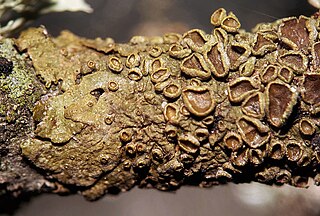
Melanohalea subolivacea, commonly known as the brown-eyed camouflage lichen, is a species of foliose lichen in the family Parmeliaceae.

Hypogymnia physodes, commonly known as the monk's-hood lichen, is a species of foliose lichen in the family Parmeliaceae. It is a common and widespread species in boreal and temperate forests of the Northern Hemisphere. It has a grey to yellowish-green thallus that is loosely attached to its substrate and forms large irregular patches. Hollow lobes are 2–3mm wide. The outer edge turns up and is frequently covered with white powdery soredia underneath. Its lower surface is black, wrinkled and has some browning toward the lobe margins. The pycnidia are black and abundant, and their presence creates a pepper-like effect across the upper surface. Because of its abundance and its moderate sensitivity to sulphur dioxide and heavy metals, Hypogymnia physodes is often used in bioindicator and biomonitoring studies that enable the assessment of air pollution and other environmental conditions.
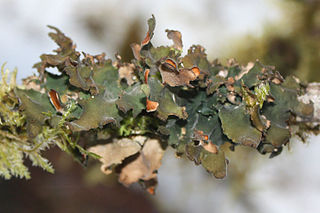
Nephroma resupinatum, commonly known as the pimpled kidney lichen, is a species of foliose lichen in the family Peltigeraceae. It was first described by Carl Linnaeus in his 1753 work Species Plantarum as Lichen resupinatus. Erik Acharius transferred it to the genus Nephroma in 1810.

Punctelia hypoleucites, commonly known as the southwestern speckled shield lichen, is a species of foliose (leafy) lichen in the family Parmeliaceae. First formally described by Finnish botanist William Nylander as a species of Parmelia, it was transferred to the genus Punctelia in 1982. The lichen is found in Africa, North America, and South America, where it grows on the bark of both hardwood and coniferous trees. Its greenish-grey thallus is covered with tiny white pseudocyphellae – minute holes in the thallus surface that facilitate gas exchange. Some macroscopic features that help distinguish this species from other related members of the genus include the presence and the structure of the apothecia, the absence of asexual surface propagules, and the light brown color of the thallus undersurface. Chemically, the presence of lecanoric acid in the medulla and atranorin in the cortex help distinguish it from lookalikes.

Punctelia bolliana, the eastern speckled shield lichen, is a species of foliose lichen in the family Parmeliaceae. It is found in North America, with a distribution extending from the Canadian province of Ontario south to the central and northeastern United States and Mexico. It grows on the bark of both deciduous trees and coniferous trees. The combination of characteristics that distinguishes this species from others in genus Punctelia are the absence of the vegetative propagules isidia and soralia, a pale brown lower thallus surface, and the presence of the secondary chemical protolichesterinic acid in the medulla.

Punctelia graminicola is a species of foliose (leafy) lichen in the family Parmeliaceae. It grows on rocks, and, less frequently, on bark in North America, South America, and East Africa. It has a blue-grey thallus measuring up to about 15 cm (6 in), covered with tiny pores called pseudocyphellae. Sometimes the lichen forms small lobes that project out from the surface. Fruiting bodies are uncommon in this species; if present, they resemble small cups with a brown internal disc measuring 3–10 mm (0.1–0.4 in) in diameter. A lookalike species, Punctelia hypoleucites, is not readily distinguishable from Punctelia graminicola by appearance or habitat alone; these species can only be reliably differentiated by examining the length of their conidia.

Cetrelia chicitae is a species of foliose lichen in the family Parmeliaceae. It is found in eastern Asia, North America, and Europe, where it grows on mossy rocks and tree trunks.
Parmelia mayi is a species of foliose lichen in the family Parmeliaceae. It is found in the northern Appalachian Mountains of eastern North America, where it grows on rocks and on the trunks of paper birch and balsam fir. Parmelia mayi is morphologically indistinguishable from Parmelia saxatilis, but is distinct in its distribution, chemistry, and genetics.

Hypogymnia krogiae, commonly known as the freckled tube lichen, is a species of foliose lichen in the family Parmeliaceae. Found in North America, it was described as a new species in 1973 by Karl Ohlsson. The type specimen was collected near Cheat Bridge, West Virginia by Mason Hale in 1956.

Hypogymnia flavida is a species of foliose lichen in the family Parmeliaceae. It is found in mountainous locations of east Asia, where it grows on the bark and wood of woody plants. It has a relatively large yellowish thallus.
Hypogymnia wilfiana is a species of foliose lichen in the family Parmeliaceae. It is found in western North America, where it grows on conifer trees.















